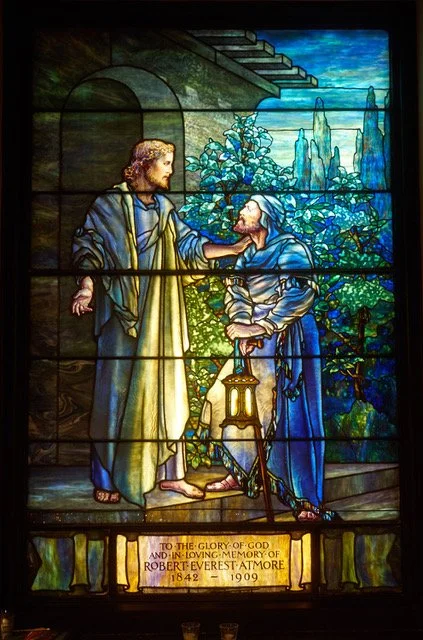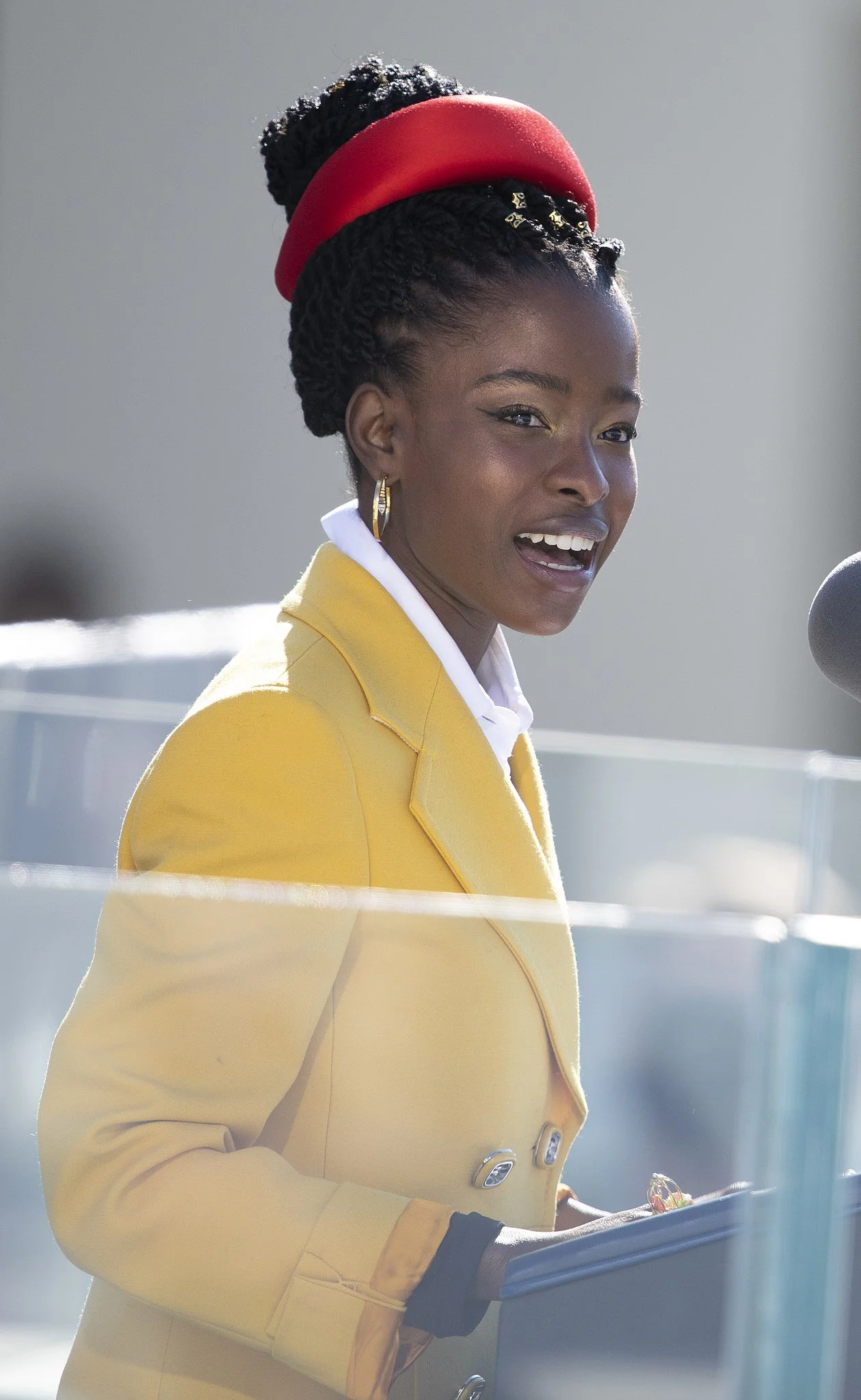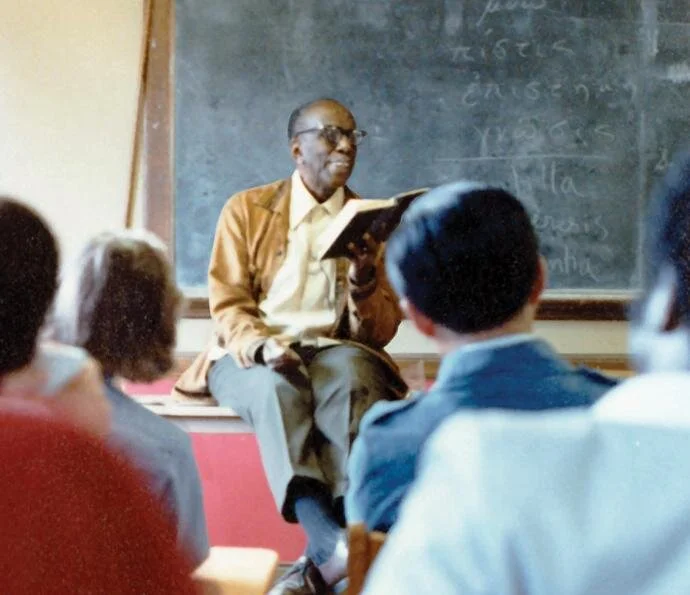Friday Reflection Part II: A Modern Mission for Today’s Tensions
Rev. Dr. Alfred W. Price
There are uncanny affinities between Columba and one of St. Stephen’s recent rectors who—literally and figuratively—looms large in church memory: The Rev. Dr. Alfred W. Price (1899-1992), rector from 1942 to 1971. Like Columba, Dr. Price emanated powerful command presence in part because of his great height and expressive demeanor. Both the monk and the rector established energetic communities of religious and laypersons. Both were accomplished missionaries with a compelling ability to connect and a fierce sense of calling—in Dr. Price’s case, often conveyed within disarming geniality and humor. Both were also noted healers.
With many publicized healings to his credit, Dr. Price is one of the most famous American advocates and practitioners of a Spiritual Healing that emerged in the Anglican community in the UK in the early 20th century as an alternative to existing versions (notably spiritualist, Christian Scientist, and Pentecostal). Adhering strictly to Scripture, this quest for wholeness—healing and reintegrating mind, body, and life using science and worship, and reconnecting with the divine—developed as a form of Living the Gospel. Practitioners obeyed Christ’s mandate to his followers to continue his work in healing those who requested it. Across time, Christ the Great Healer participated through such earthly deputies, ordained or lay.
Dr. Price introduced this form of Spiritual Healing into St. Stephen’s worship program within his first weeks there in 1942, when he added a brief midday healing service on Thursdays. He soon formalized his healing mission by joining the successor to the English society, the Order of St. Luke the Physician (OSL), founded in San Diego in 1947, and became its warden (director) even as it went international.
Open to all, the healing service at St. Stephen’s drew such crowds that a second service was added Thursdays at 5:30. Under Dr. Price, St. Stephen’s became the national center of Spiritual Healing through the OSL (eventually an ecumenical community), hosting annual conferences that were massively attended by clergy, laypersons, and physicians. Dr. John Gaynor Banks, founder of the OSL, held at least one mission at St. Stephen’s before he died in 1953. Dr. Price himself traveled frequently to run and establish programs elsewhere. In that sense he was very much the evangelizing missionary.
According to Grace McKelvey, an admirer and frequent published interviewer, his presence during a healing service made the miracle clear: “The first time I sat in the back of his church and watched his great body bending tenderly over the kneeling, troubled souls before him, I FELT [original emphasis] the presence of the Healing Christ.”
Dr. Price did not found St. Stephen’s, as Columba did his abbey on the Isle of Iona. But he revived a historic church affected by the suburban exodus and the deterioration of the neighborhood after the Depression. Dr. Price claimed he began by throwing open the doors to all—and they came, businesspeople [strangely, no mention of nearby physicians], “hoboes,” prostitutes, one of whom, he claimed, became St. Stephen’s organist. He was a consummate leader, administrator, fund-raiser, and public relations magician. He eventually built a huge attendance (in 1958 alone, 51,526), a thriving congregation in repaired historic buildings, with a new organ, no debt, and a generous endowment. In 1958, St. Stephen’s stopped using the controversial but financially vital system of pew rentals. This was the ultimate commitment to openness to all.
In his description of those who walked in the door when invited, Dr. Price reported colorful forms of social diversity, but not where skin was involved. During these years of mounting racial confrontation, St. Stephen’s remained white, even though it sat on the edge of Chinatown. Surviving photographs of events at the wartime Old St. Stephen’s Club for servicemen show one Asian and no blacks.
In his sermon “Follies of 1946,” Dr. Price presented a liberal social and political program that is startlingly current today. Among his stated follies, he identified acquisitive individualism that ignored social values and collapsed economic life; economic privilege vs. guaranteed economic security; even distribution of labor. He condemned class-conscious society and divisions despite protests. You need “courage to be genuinely democratic, the “daring to be just,” he maintained.
There, Dr. Price didn’t mention race.
But did so later, in addresses to his congregation with subtleties that deserve consideration, especially since social justice is an unfamiliar side of his advocacy and ministry. Here I thank Mike Krasulski yet again, for his philadelphiastudies.org, which offers so much of this documentation.
In welcoming essays within service leaflets, Dr. Price included anecdotes about current anti-black prejudice among whites, many of which were from black friends. In “The Only Answer,” published in the service leaflet of May 28, 1961, he wrote about his accomplished and widely respected friend, writer, minister, and social advocate Howard Thurman (1899-1981).
Dr. Howard Thurman
Pointedly for his white congregation, Dr. Price noted: “Once you know him, you don’t notice that his skin is darker than yours.” Yet Dr. Thurman regularly suffered whites’ insults. One such challenged him as an invasive “what” on a train (he successfully bought a ticket which the conductor accepted). A white woman snubbed him when he courteously opened a door for her. Dr. Thurman admitted to dying daily in reaction, making room for divine love and presence. Observed Dr. Price when whites reported growing mysteriously in the eminent black's presence: “Of course people feel taller when they leave Dr. Thurman—because Christ lives in him, the same Christ who loved proud and mistaken men in His day on this earth.” Dr. Price contended we need more like him. I wonder how Dr. Price contributed to Dr. Thurman’s vital backstage work in social justice.
Other such stories from black clerical friends who were regularly assaulted are gently homespun, some are tragically biblical. In one of the last (June 4, 1967, “Father Forgive Them”), Dr. Price quoted Martin Luther King, Jr.’s forgiveness of racial hostility as blindness: “’We must recognize that Jesus was nailed to the Cross not simply by sin but also by blindness.’” Dr. Price consequently urged his readers to listen, “for it may be that you will suddenly hear Jesus crying out once more, ‘Father, forgive them . . . ‘” I wish I had Dr. Price’s response to MLK’s assassination the following year.
In identifying with his readers with these stories (“we White people”), Dr. Price nudged them along, shoulder to shoulder, through suggestion, empathy, placing them in the shoes of an admirable contemporary of color, through wry humor and Christ like forgiveness of blindness. He emphasized that he respected and listened to this community, as his white companions should.
Dr. Price’s practice and advocacy of social justice is closely linked to Spiritual Healing. Both aim for wholeness, personally, interpersonally, and Beyond. Achieving social harmony, after centuries of often-violent divisiveness, wherever, whatever color or creed, is, as is often said, a form of healing.
—Suzanne Glover Lindsay, St. Stephen’s historian and curator










